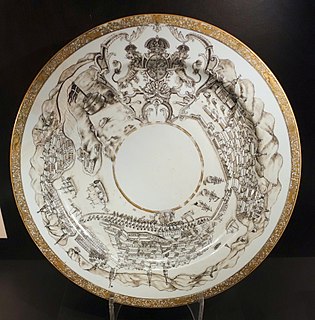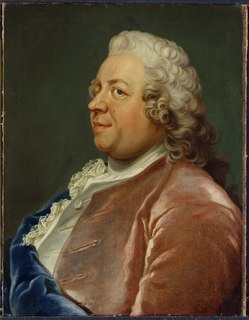
The Swedish East India Company was founded in Gothenburg, Sweden, in 1731 for the purpose of conducting trade with China and the Far East. The venture was inspired by the success of the Dutch East India Company and the British East India Company. This made Gothenburg a European centre of trade in eastern products. The main goods were silk, tea, furniture, porcelain, precious stones and other distinctive luxury items. Trade with China saw the arrival of some new customs in Sweden. The Chinese cultural influence increased, and tea, rice, arrack and new root vegetables started appearing in Swedish homes.

A boat or ship engaged in the tramp trade is one which does not have a fixed schedule, itinerary nor published ports of call, and trades on the spot market as opposed to freight liners. A steamship engaged in the tramp trade is sometimes called a tramp steamer; similar terms, such as tramp freighter and tramper, are also used. Chartering is done chiefly on London, New York, and Singapore shipbroking exchanges. The Baltic Exchange serves as a type of stock market index for the trade.

Canton or Cantonese porcelain is the characteristic style of ceramic ware decorated in Guangzhou, the capital of Guangdong and the sole legal port for export of Chinese goods to Europe. As such, it was one of the major forms of exportware produced in China in the 18th and 20th centuries.

Götheborg is a sailing replica of the Swedish East Indiaman Götheborg I, launched in 1738. All sailors survived when the original ship sank off Gothenburg, Sweden, on 12 September 1745, while approaching the harbour on her return from a third voyage to China. Construction of the replica started in 1995, with the hull launched in 2003, and the rig fully tested for the first time in 2005. Much of the time was spent researching how to rebuild the replica. In 2008, Götheborg completed the first Baltic Sea Tour. It is one of the world's largest operational wooden sailing vessels.

East Indiaman was a general name for any sailing ship operating under charter or licence to any of the East India trading companies of the major European trading powers of the 17th through the 19th centuries. The term is used to refer to vessels belonging to the Austrian, Danish, Dutch, English, French, Portuguese, or Swedish companies.

The Thirteen Factories, also known as the Canton Factories, was a neighbourhood along the Pearl River in southwestern Guangzhou (Canton) in the Qing Empire from c. 1684 to 1856 around modern day Xiguan, in Guangzhou's Liwan District. These warehouses and stores were the principal and sole legal site of most Western trade with China from 1757 to 1842. The factories were destroyed by fire in 1822 by accident, in 1841 amid the First Opium War, and in 1856 at the onset of the Second Opium War. The factories' importance diminished after the opening of the treaty ports and the end of the Canton System under the terms of the 1842 Anglo-Chinese Treaty of Nanking. After the Second Opium War, the factories were not rebuilt at their former site south of Guangzhou's old walled city but moved, first to Henan Island across the Pearl River and then to Shamian Island south of Guangzhou's western suburbs. Their former site is now part of Guangzhou Cultural Park.

Moshulu is a four-masted steel barque, built as Kurt by William Hamilton and Company at Port Glasgow in Scotland in 1904. The largest remaining original windjammer, she is currently a floating restaurant docked in Penn's Landing, Philadelphia, adjacent to the museum ships USS Olympia and USS Becuna.

Colin Campbell was a Scottish merchant and entrepreneur who co-founded the Swedish East India Company and was Swedish King Fredrik I's first envoy to the Emperor of China.

Pazhou is a subdistrict of Haizhu in southeastern Guangzhou, Guangdong Province, in China.
General Hewett, sometimes spelled General Hewart or General Hewitt, was a three-deck sailing ship launched at Calcutta in 1811. The British East India Company (EIC) purchased her to use her in the China trade. However, unlike most East Indiamen, on her first voyage from England she transported convicts from England to Australia. Thereafter, she performed five voyages for the EIC. The EIC sold her in 1830 and she then became a general merchantman. In 1864 she was sold for a hulk or to be broken up.
Broxbornebury, was a three-decker sailing ship launched in 1812. She made four voyages for the East India Company (EIC), one voyage transporting convicts to Australia, and numerous other sailing voyages. She was sold in 1844 for breaking up.

Puankhequa, also known as Pan Wenyan or Zhencheng, was a Chinese merchant and member of a cohong family, which traded with the Europeans in Canton during the Qing dynasty (1644–1912). He owned a factory in the Thirteen Factories district where his firm was favored by the English, Swedes, "Imperials" and Danes.

Jean Abraham Grill, sometimes called Johan Abraham Grill, was a Swedish merchant, supercargo, director of the Swedish East India Company (SOIC) and ironmaster at Godegård with several factories.

Events from the year 1733 in Sweden

India–Sweden relations are the bilateral ties between India and Sweden. Sweden recognised India's independence from the United Kingdom in 1947; both nations established formal diplomatic relations in 1949. India has an embassy in Stockholm, while Sweden has an embassy in New Delhi and honorary consulates in Chennai, Kolkata and Mumbai.
Susan was launched at Calcutta in 1813. She initially traded in the East Indies as a country ship, and with Britain under license from the British East India Company (EIC). Between 1829 and 1831 she made two voyages for the EIC. Then between 1834 and 1836 she made four voyages transporting convicts, two to New South Wales, and two to Tasmania. She foundered in 1846 as she was sailing between London and the Cape of Good Hope.
Sullimany, was built at Demaun between 1795 and 1799, registered in Bombay after 1803, and was still sailing c.1840. She was originally a country ship. A French privateer captured her in 1799, but an East Indiaman fortuitously recaptured her shortly thereafter. She also served as a transport in two British military campaigns.
Mulgrave Castle was launched in 1813 at Scarborough and spent much of her career sailing between England and India under a license from the British East India Company (EIC). In 1816 she was the subject of a notable incident at Cape Verde. She was wrecked in 1825.

Claes Grill was a Swedish merchant, factory owner and ship-owner. He was director of the Grill Trading House, one of the leading companies in the East India trade through the Swedish East India Company (SOIC). The trading house also ran a banking business and owned several ironworks in Sweden. Grill also owned several estates, was interested in natural science and had a brief and unsuccessful political career.
Atahualpa was a United States merchant ship that sailed on four maritime fur trading ventures in the early 1800s. In 1813, in the Hawaiian Islands, Atahualpa was sold to the Russian-American Company (RAC) and renamed Bering or Behring. In January 1815 Bering, under the command of the American James Bennett, returned to Hawaii where it was wrecked at Waimea Bay, Kauai.














